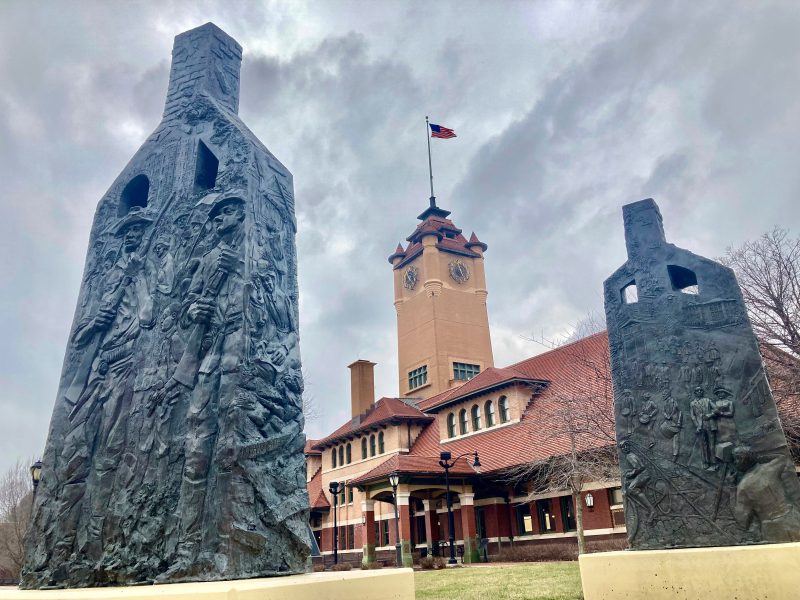In 1908, a White mob incited a race riot in Springfield, Ill., leaving several people dead, hundreds injured and dozens of Black-owned businesses and homes burned and destroyed.
On Friday, President Joe Biden will designate a national monument to commemorate the violent event, the White House confirmed to The Washington Post on Wednesday.
Biden, aiming to bolster his record on racial justice as he prepares to leave office in January, will sign the designation proclamation during an event at the White House with civil rights leaders and Illinois lawmakers. The proclamation, which has not previously been reported, will come during the 116th anniversary of the riot.
It also follows the fatal July 6 shooting of Sonya Massey, a 36-year-old unarmed Black woman in south Springfield, by an Illinois sheriff’s deputy. Massey’s death has reignited a reckoning in her hometown and across the country over police brutality against Black Americans — four years after George Floyd’s murder by Minneapolis police sparked global protests over racial inequality.
Four lawmakers from Illinois — Sens. Tammy Duckworth (D) and Dick Durbin (D) and Reps. Nikki Budzinski (D) and Darin LaHood (R) — introduced legislation to create the national monument under the National Park Service. But the measure has stalled amid the gridlock on Capitol Hill in an election year.
Biden will bypass the gridlock by using his executive authority under the Antiquities Act, a 1906 law that authorizes the president to protect lands and waters for the benefit of all Americans. He has designated five new national monuments and expanded four others, part of his ambitious plan to conserve 30 percent of the nation’s lands and waters by 2030.
The bipartisan bill “has stalled in the House, unfortunately, but the president’s action will make sure this monument will happen,” Durbin said, adding that the riot demonstrated that “racism was not confined to the Confederate states. And I hope that Springfield, after the tragedy of Sonya Massey, will move forward to reduce and eliminate racism.”
Duckworth agreed that the monument could help spread awareness of the racial violence that occurred outside the Jim Crow-era South. “I don’t think people think of the Midwest, and especially Illinois, as a place where these horrific events in American civil rights history happened,” she said.
The riot began on the evening of Aug. 14, 1908, when a mob of roughly 5,000 White people gathered outside the city jail. Tensions rose as the mob called for releasing and lynching two Black male prisoners: George Richardson, who had been accused of raping a White woman, and Joe James, who had been accused of murdering a White man.
The sheriff, fearful of violence, secretly removed the two prisoners through a back door and put them on a train to a jail in Bloomington, Ill. Then he announced that the prisoners were gone, assuming the crowd would disperse.
He was sorely mistaken. Members of the mob, angry that they had been tricked, rampaged through the city’s Black neighborhoods, looting and destroying dozens of Black-owned businesses and homes. At least nine Black residents died, including two who were lynched: Scott Burton, a barber, and William Donnegan, a cobbler and conductor on the Underground Railroad.
The financial losses from the violence totaled $150,000, or more than $5 million in today’s dollars. The Illinois National Guard was eventually called in to restore order.
Two weeks after the riot, Mabel Hallam, the White woman who had accused Richardson of rape, recanted her claims, and the charges against Richardson were dropped. James was sentenced to death and executed, despite little evidence linking him to the murder.
The riot had immediate ripple effects; It led the founding of the NAACP in 1909. But more than a century later, some Black residents of Springfield say the community has literally and metaphorically buried the horrific incident in its past. The site of the riot has been paved over for a parking lot, and the incident is not taught in Springfield public schools.
“When you cover things up, the wound will eventually fester like a raisin in the sun,” said Ken Page, president of the Springfield chapter of the American Civil Liberties Union of Illinois. “There is now an opportunity for schoolchildren to visit that site and also to understand it. … I think it’s extremely important for us to know our history so that we do not repeat it.”
Physical traces of the riot recently resurfaced in a surprising way. In 2014, an archaeological dig for a high-speed-rail project uncovered the foundations of five houses that burned down in the riot, along with artifacts from their occupants.
Floyd Mansberger, director of Fever River Research, which conducted the archaeological work, said his team found several artifacts that helped counter racist and inaccurate reporting by early-20th-century newspapers, which described the city’s Black residents as “disreputable” and “living in huts and shanties.”
For example, the firm found three military medals that belonged to a young Black man named Robert Wright, who had enlisted in the 8th Infantry Regiment of the Illinois National Guard, the nation’s first all-Black officer corps. The team also uncovered the burned remains of a book, clothing and jewelry — including a 14-carat gold wedding ring — that belonged to a young Black woman named Bessie Black.
“The archaeology really helps us understand the reality of who these people were versus the perception of who these people were,” Mansberger said. “And that goes to great lengths to help us learn who was impacted by this horrific event and how we can move forward.”
An ongoing fight
Springfield, the capital of Illinois and a city of roughly 110,000, is known for its connections to two U.S. presidents who made history on issues of race: Abraham Lincoln and Barack Obama. They both launched their political careers in Springfield, and tributes to them are everywhere.
But in recent weeks, the city has made national news for a different, darker reason — Massey’s death. On July 6, Massey called 911 to report a possible intruder in her home in south Springfield. Sangamon County Sheriff Jack Campbell and Deputy Sean Grayson responded to the call after midnight.
According to body-camera footage, Massey lifted a pot of boiling water from the stove, and Grayson said he was stepping back “away from your hot steaming water.”
“I rebuke you in the name of Jesus,” Massey said in response.
Grayson warned Massey not to rebuke him and threatened to shoot her in the face. Then he drew his gun, ordered her to drop the pot and fired at least two shots at her.
Massey was pronounced dead in the same hospital as Donnegan, the Black cobbler who was lynched during the 1908 race riot. According to her family, Massey was also a direct descendant of Donnegan — a “tragic parallel,” said Cedric Haynes, vice president of policy and legislative affairs for the NAACP.
The day before Massey was shot, her mother called 911 to report that her daughter was having a mental breakdown. The mother implored law enforcement officers not to harm her daughter, 911 recordings show.
Grayson, 30, is charged with first-degree murder and has pleaded not guilty, saying he acted in self-defense. He has since been fired. In the face of public outcry, Campbell has said he will retire by the end of the month.
Austin Randolph, president of the Springfield chapter of the NAACP, said the community is still reeling from Massey’s death. He said the new monument could help bring greater attention to Black Americans’ ongoing struggle for equality and justice in Springfield and nationwide.
“Racism has not gone away — it’s been around for a long, long, long time,” Randolph said. “We must fight against racism, segregation, hatred and violence. And this monument will stand as a testament to fighting that battle.”

